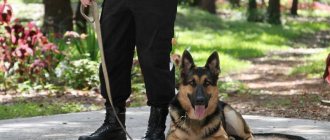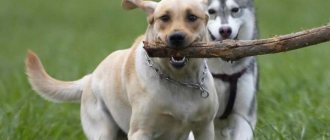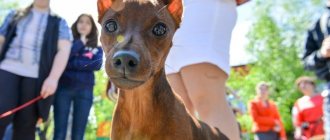When buying a dog, the owner needs to take into account that now he will have to take full responsibility for a full-fledged family member and spend most of his life training him. After all, in order for a dog’s communication with people to be comfortable for everyone, he needs to go through an entire obedience school. A general training course is ideal for raising a dog: after it, the dog will become obedient, learn basic commands and learn the skills of living next to a person. But first things first.
OKD for dogs
What is OKD?
The general training course (GTC) was developed by Soviet dog handlers about a century ago. This is a school that allows you to correct a dog’s behavior and instill unconditional obedience in it. The strict requirements that are imposed on each dog during the course are recognized as basic, and the level of proficiency in the standards is checked at all specialized competitions.
Definition of OKD
OKD has not lost its relevance all these years, surpassing all new techniques in its effectiveness. The course must be completed by:
- four-legged rescuers and police officers;
- service dogs;
- fighting dogs acting as a guard in a private home.
As a rule, fighting breeds are born with too much energy and hidden aggression. If they are not directed in the right direction with the help of OKD, the uncontrolled aggression of dogs will become dangerous for other animals and people. In addition, OKD is also suitable for ordinary pets. The courses will help owners establish good contact with their dog, gain complete control over it and receive only positive emotions from walks.
Courses help owners establish good contact with their dog
Grades, degrees, differences
First of all, OKD has two standards: test and competition. Dogs over one year old, of any breed and size, are allowed to take part in the tests. The overall impression and quality of control of the dog when performing various elements are assessed. The dog should not show cowardly or aggressive behavior, and calmly and joyfully do what the handler orders from the first command.
The final degree depends on how many points you receive. It determines the level of training. The largest number is one hundred points, the smallest is sixty.
- from 90 to 100 - first degree
- from 70 to 89 - second degree
- from 60 to 79 - third degree
A dog with less than sixty points is considered to have failed the test. But even if such a nuisance happened, this is not a reason to panic: the OKD can be taken again, but not earlier than in a month.
Those for whom everything went well are given a diploma certified by the RKF and a token, and in the pedigree of the descendants they indicate the name of the discipline completed by the parent, indicating the assigned degree.
Only those tailed animals that have successfully passed the tests can participate in OKD competitions. This standard is slightly different from the previous one, and the work is assessed in two tests: personal and team. For those who are small in stature (42 cm or less), they came up with a mini-OKD, in which everything was adapted to their characteristics.
The winners receive medals and cups, they are also given diplomas and tokens.
How much does it cost to undergo OKD with a trainer?
Typically, courses are conducted with qualified dog handlers who require a fixed price for their services. The price range looks something like this:
- 7,000 rub. – average cost of group training;
- 16,000 rub. – a course of individual lessons with a trainer.
The prices are approximate, since the coach has the right to set an individual price depending on the region of residence and his own qualifications. So, for the money paid, the client will receive 16 classes in which the dog is present together with the owner. Training can take place in a group with other dogs or alone with a trainer for particularly obstinate dogs.
Prices for classes depend on the region of residence and the qualifications of the trainer.
Important! Sick dogs and bitches in heat are strictly not allowed to take the course. A dog in heat will distract other animals from training, and a fight may break out between the dogs.
Required equipment
To pass the OKD, regardless of whether it is carried out with or without a coach, you will need:
- a collar in which the dog feels comfortable (of a suitable size);
- long (5-8 m) and short (1.5-2 m) leashes (it is better not to use a tape measure);
- comfortable muzzle of any type, except loop;
- an object to mark a place, usually a rug;
- aportable item;
- a bag with a long strap for treats so that your hands are free.
By working with your pet and teaching it basic skills, you will not only learn how to control the animal, but also become closer to it and begin to understand it better. Dogs, for the most part, love to learn, as it involves playing and being rewarded with treats, the main thing is to be patient and work hard.
Do you like the article? 217
Self-training a dog
Some breeders still choose independent training, arguing that it is a desire to save money or to entrust the dog to a stranger. But is it possible to undergo OKD without a trainer no less effectively than with one?
It is quite possible to teach a domestic dog OKD on your own.
The result of education depends on two factors:
- dog's intelligence. If a dog has good mental abilities from birth, he will quickly understand what his owner wants from him, and training will be easy and relaxed;
- persistence and patience of the owner. It is important to remember that one command will have to be repeated many times. If the owner does not have enough patience for this, training will not be successful.
It is quite possible to train a domestic dog to do OKD on your own. The exception is overly aggressive leader dogs, which are difficult to train in any way.
Who needs to take the OKD course?
Why you should give your puppy for training
By giving the puppy to an experienced instructor for training, the owner hopes that his pet will quickly master the general course. He's right about that. It will not be difficult for a professional to teach an animal basic commands. To do this, he will need several days to establish contact with his ward, and a month to master the basic commands.
But the owner loses sight of the fact that by giving the pet into the wrong hands, he will not watch it grow up. But this is only one side of the coin. A dog trained by a trainer will not show the same results at a show with its owner, since it is accustomed to obeying another person.
It's even worse with hunting dogs. A well-trained hunting dog, with a diploma, obeys only a specific person. She may refuse to work with the owner. Only an experienced hunter can convince her.
Attention! Even when you give a dog to a trainer with maintenance and receive a well-trained dog back, you cannot be sure that it will obey its owner.
The dog is used to listening to the trainer. In order to achieve what you want, you need to do extra work with your pet at home in addition to classes at school.
Then there will be mutual understanding and obedience. If nothing has changed in the parent’s house, the ward is fed deliciously and nothing is demanded of him, then the training will return to the stage from which it began, to disobedience and bad habits. Training may only last for a short time.
Training in basic programs
What is included in OKD without a coach?
OKD consists of a number of basic commands that are useful for every dog. The owner can choose several basic commands that are suitable for his dog. If desired, additional training is gradually added. The general course includes:
- commands “Come to me”, “Nearby” for good behavior during a walk;
- the skill of giving away a toy upon the owner’s first request;
- skills to sit, lie down and sit down after the trainer’s order;
- commands “Fu” and “Place”;
- commands “Aport” for active games and “Fas” for emergencies.
What commands to teach in OKD courses
In addition, it is important to teach the dog to be patient from the first days. You should start with a short period of time, gradually coming to a long period. Below are some basic commands that are used during OKD, and recommendations for teaching them.
What commands to teach in OKD courses. Part 2
Skill 1: responding to a nickname
It is necessary to instill in a puppy a reaction to his name from the first days of his appearance in the house. Before starting the lesson, you should stock up on your dog's favorite treat. As a rule, training lasts no more than 2-3 days and follows the following algorithm:
- the owner pronounces the nickname while being at a distance of several steps from the baby. When he looks towards the person, you need to praise him;
- when the puppy runs up to the person after the named name, you need to give a treat, pat the fur and call the dog by name several more times;
- Then the lessons should be made more complex: the puppy is called while he is playing, distracted by external stimuli while walking, or busy communicating with another puppy. When the dog approaches after being called, it is praised and given a treat;
- When the dog begins to unquestioningly approach his name, the feeding is gradually removed. Treats are replaced by praise and stroking, which also gradually fade away.
By the way! You can teach during each meal. To do this, the owner puts food in a bowl and, holding it in his hands, calls the puppy by name. When he runs up, the owner praises him with the word “Good!” or “Well done!”, after which he puts the plate down. While the pet is eating, the trainer pets it and repeats its name.
Video - Basics of training a puppy
Skill 2: learning the commands “Lie down”, “Sit”, “Stand”
These are the basic commands that every dog should know. The standard is considered fulfilled if the animal remains sitting in place after the owner moves 10-15 meters away from him. Each order is executed 2 times from different positions. After the command, the pet must freeze and remain in this position as long as necessary, otherwise the standard will not be counted.
How, where and how long to train a dog
The algorithm for teaching commands is as follows:
- " Sit" . The owner calls the pet to him and raises the treat above his head so that he can see it only after he sits down. Then the man clearly says the command. After the dog sits, you need to praise it and give it a treat. Repeat daily until completely fixed;
- "Lie" . While the dog is sitting, the owner commands “Lie down” and shows the treat just above the ground so that the dog reaches down and forward for it. If the dog does not obey, although this rarely happens, you can put your hand on the withers and press down a little;
- "Stand". The easiest way is to train near the owner's feet. The trainer commands “Nearby”, walks a few meters with the dog, and then stops. The dog sits near the left leg. Then the owner loudly says “stand”, bends down and lifts the dog, holding it under the belly. After a few seconds, the dog needs to be praised and given a treat.
How are OKD classes conducted?
Skill 3: Voice command
Use this command to search for suspicious objects or a hidden person. This command also allows you to find the animal if the owner has lost sight of it: you should loudly say the name and the “Voice” command, after which the dog will report its location.
The “Voice” command allows you to find an animal if the owner has lost sight of it
This command is taught when the dog already has the skills “Sit”, “Stand” and “Lie down”. The principles look like this:
- before the start of the lesson, the animal should not be fed: for better assimilation of the command, it should be hungry;
- Put a collar with a short leash on the dog, and then order it to sit. Place the strap on the ground and stand on it so that the dog does not have the opportunity to jump;
- the owner takes the treat in his hand, pulls it forward over the dog’s head and waves it left and right. Wait until the student focuses on the piece and barks. Then the dog needs to be praised and treated;
When giving your dog a treat, it is important to know when to stop it, otherwise it will lose its effectiveness.
- You can use a bowl of dog food as a motivator. You need to place it on some shelf in the kitchen where the dog cannot reach. While the dog is trying to get to the food, you need to repeat the “Voice” command, and as soon as it barks, take out the bowl and give it to the dog;
- You can also use your dog's favorite toy for training. It is raised above the animal's head and moved left and right, repeating the command. As a rule, the dog quickly begins to bark, after which the toy is given to it and praised. At the same time, you can train the “Give” command while taking the toy.
Fourth and fifth OKD lessons
Important! If none of the methods work, an assistant joins the training. The animal must be tied to a tree with a short harness, while a stranger slowly approaches it. He waves his hand, and the owner gives the command “voice”. When the dog barks, you need to praise him and feed him a treat.
Video - How to teach a dog the “Voice” command
Skill 4: Teaching the Near Command
Possession of this skill will make the dog manageable in the process of meeting standards for overcoming obstacles, walking without a harness, and in other cases. It is most convenient to combine team training with hurdle jumping training. So, the algorithm will be like this:
- put a collar on the student along with a short leash, then order him to move next to him and go forward;
- say the order “Nearby” and begin to hold the dog, weakly pulling the strap towards you;
- if the animal pauses, you need to praise it and offer something tasty.
Execution of the “Nearby” command
After mastering movement on the ground, the command is practiced on a log and ladder. But you shouldn’t get too carried away with training on obstacles, since the animal’s speed may significantly decrease when overcoming them.
Video - Basic mistakes when teaching the “Nearby” command
Habit 5: Avoiding Feeding
It is important to teach your dog not to take food from the hands of a stranger, because not everyone wishes the best for the pet: someone may try to poison it using a fresh piece of meat. In addition, avoiding food will help your dog focus on his job duties.
It is very important to teach your dog not to take food from the hands of a stranger.
The dog should take food exclusively from the hands of the owner. Accustoming to this begins when the dog has learned the commands “No” or “No”, and consists of several stages:
- practicing the primary skill: the owner puts a bowl of food in front of the dog, but does not allow him to take the food, repeating the phrase “No”. After holding for 30-40 seconds. Allow the dog to eat the food. Lessons are repeated regularly, and the exposure time gradually increases to 5-10 minutes;
- After mastering the skill, it’s time to practice refusing food from someone else’s hands. To do this, an assistant trainer approaches the dog, which is tied to a tree, with a piece of meat in one hand and a twig in the other. The assistant offers meat to the dog. If he decides to take the food, the owner needs to shout “Fas” and point to the stranger, who at the same time delivers a couple of gentle blows to the animal’s limbs;
Refusal to accept food from someone else's hands allows you to reliably protect your dog during walks.
- if the dog did not take the meat and began to bark at the stranger, the owner rewards him with a treat from his hand and strokes him. The pet must clearly understand that only food from the owner’s hands is safe and pleasant;
- first, the assistant takes the food with him, and after the dog has learned the skill a little, he throws the meat in front of the trainee and leaves. If the dog wants to eat food, the owner must strictly say “Ugh” and pull the strap towards himself. If the dog remains sitting motionless, it must be praised and encouraged.
Such lessons are held about 3-4 times daily. The place where the action takes place, as well as the type of food and the assistant, change regularly. In order for the training to be successful, you can start the first classes only with a well-fed pet, and then - 2-3 hours after eating.
Video - How to stop a dog from picking up
Skill 6: Wearing a Muzzle and Showing Bite
According to the rules of the OKD, the dog must calmly accept the muzzle. When passing the standards, the owner puts a muzzle on the dog and gives the command “Walk”, and then calls the dog and removes the muzzle. The dog should not give any reaction to the muzzle.
Getting used to a muzzle is not easy for dogs.
Accustoming to a muzzle begins at the age of 3-4 months. The owner puts a piece of cheese or a dog biscuit inside the structure and gives the dog a treat, repeating the lesson several times. Then, when the dog completely tucks its muzzle in, you need to snap the muzzle onto the back of its head and immediately remove it. Gradually, the time spent in the muzzle increases. Showing the bite is more of a psychological technique that has no practical purpose. After the command “Teeth,” the owner parts the dog’s lips and shows its teeth to the judge. At the same time, the animal should treat such manipulations calmly.
By the way! This command is useful not only when demonstrating to a judge, but also during ordinary veterinary examinations. It allows the dentist to examine the dog's jaw and teeth and identify possible problems. You can read about malocclusions in dogs below.
Types of malocclusion in dogs
Skill 7: Overcoming Obstacles. Shells for OKD
Jumping over barriers and other active activities have a good effect on the physical condition of the animal. The dog becomes more agile, bold, muscular, and its movements become clearer.
The first lessons with jumping over barriers begin simultaneously with learning the skills of fetching, as well as after getting acquainted with the sit command. The main obstacles that are used in OCD and the nuances of training are presented in the table below.
Table 1. Obstacles used for training in OKD
| Let | Description of the obstacle | Learning algorithm |
| Fence without holes | A blank wall is about 2 m in height and with a similar width. The boards are removable, so the height can be adjusted if necessary | 1. Put a collar with a long leash on the dog. The dog must sit 3-4 meters from the barrier, after which the owner throws the harness over the fence and stands behind him; 2. call the student to you with the command “Come to me”, and to jump, command “Forward” or “Barrier”; 3. following the successful completion of the exercise, praise the pet and reward it with a treat |
Ladder | An area measuring 1x1 m at a height of 3 m above the surface. The width of the steps is about 15 cm, the stairs are mounted at an angle of 45°. Height between steps 25 cm | 1. The dog is on a short leash. At the command “Nearby,” the owner and the animal approach the stairs; 2. after the order “forward,” the two of them begin to walk up it; 3. the order “Forward” must be voiced several times; 4. when the dog reaches the landing, you need to praise him and start going down. It is much more difficult for dogs to go down than to go up, so the owner must move slightly ahead and control the process; |
Boom (log) | It is a structure made of a board about 5 m long and two ladders of 18 cm each, located a meter above the ground. 1.5x3 cm boards are attached to the ladders | 1. A dog on a short leash approaches the boom together with its owner; 2. the pet needs to sit a meter away from him; 3. after the order “Forward”, the owner begins to lead the dog along the ladder with gentle pull-ups, pronouncing the command again and again; 4. To prevent the dog from jumping, you need to hold him by the collar and support him with your other hand under his belly; 5. in this position, walk the dog along the boom, then hand him a treat and stroke him |
Habit 8: Moving with the Trainer
The owner moves chaotically, in different attacks and at different speeds. The dog must follow next to him, not lagging behind and stopping when the trainer gets up. When stopping, the dog must sit down independently without command.
Video - After completing the course
final grade
Skill Scorecard:
| Skills Tested | Max. point | Min. point |
| 1) Demonstration of the dental system, attitude towards the muzzle, transition to a free state | 5 | 2 |
| 2) Attitude towards food, prohibiting command “Fu” | 5 | 2 |
| 3) Retrieval (carrying an object) | 13 | 8 |
| 4) Return to place | 12 | 6 |
| 5) Approach to the trainer | 13 | 8 |
| 6) Complex (stand, laying, landing) | 20 | 13 |
| 7) The movement of the dog next to the trainer | 18 | 10 |
 Overcoming obstacles Overcoming obstacles | 14 | 10 |
| 9) Controllability of the dog when shooting (included in the assessment of the skill or complex) | ||
| Total points | 100 | 60 |
Evaluation of the trainer's work:
| Unclear report to the judge | 2 |
| Every distortion of a command, a gesture | 1 |
| Late execution of the referee's command | 2 |
| Lack of necessary impact on the dog | 2 |
| Late promotion | 1 |
| Exposing the dog unnecessarily | 1 |
| Incorrect display of reception | 3 |
| Rough treatment of a dog | Removed |
| Unethical behavior | Removed |
What to consider during training
The most important points that a trainer should know before starting and during the training process are presented in the table below.
Table 2. Nuances of dog training
| Question | Answer |
| At what age does OCD begin? | Animals that are over 8 months old are allowed to enter the OCD. During this difficult period, puppies begin puberty, so a rebellious spirit, stubbornness and excessive excitability awaken in them. However, at this stage dogs are best able to absorb new information. |
| What attitude should the owner have when training? | During the training process, you should not get angry with the dog, hit it or scream. With such actions, the owner will only spoil the puppy’s sensitive psyche without achieving the desired result. |
| How is a specific skill taught? | Stage 1: getting to know the new team. The trainer needs to divide a complex skill into simple actions or explain to the dog the meaning of the exercise. Stage 2: requirement to execute the command if necessary. At this stage, it is important to achieve unquestioning execution of orders, even if the dog does not want to do anything at all. |
| How long is one lesson? | Daily lessons should last at least an hour, and in one approach, not two. So, in the first half hour the lesson is interesting for the dog: they play with it, feed it with treats. The rest of the time, a change in the dog’s character begins: the dog no longer wants to do anything, he is ready to go about his business |
| How long does it take to train an OKD dog? | If classes are held with a trainer, they last 4 months - 16 classes weekly. With a strong desire, you can finish it faster. But you need to keep in mind: you need to practice daily to get good results. |
| How to ensure correct execution of commands? | In order for the dog to get used to responding to commands quickly and on time, there is no need to repeat the order several times in a row. The command is pronounced clearly and calmly. If the four-legged animal does not fulfill it, the order is pronounced again after a few seconds, but this time it is reinforced by physical influence - for example, pulling up a leash or pressing on the withers |
Who is this course for?
Any dog needs the basics of training, but first of all you need to go through them:
- Puppies that will be exhibited in the Russian Cynological Federation (RKF). A document confirming that the standards have been passed is a mandatory condition for a participant in the competition.
- For kids of fighting breeds. Due to their temperament, it is more difficult for such dogs to restrain aggression, and the power they possess is dangerous for others. You must be confident in your pet.
- Police dogs and rescuers. Animals undergo several training courses, OKD first and these.
- Service pets (guide dogs, guards, bloodhounds, shepherds).
OKD is the basis; there is also a full training course, which must be completed by those who will work in protective guard, guard, and patrol services.
What will the dog be able to do after passing the OKD?
What does a dog learn in OKD courses?
So, it’s time to put all the information together and finally understand what the dog will be able to do after completing the full course. So, after training, the dog will have the following skills:
- leisurely walking or running near the owner on a leash or without it;
- adequate reaction to irritating factors: bright light, unexpected loud sound and others;
- quick response to orders “fu”, “no” and immediate termination of the action being performed;
- the habit of not taking food from the hands of strangers and not picking it up from the ground on the street;
- quickly sit down, lie down or get up from any position, including for a long time;
- respond with a loud bark to the command “voice”, and when ordered “place” go to your mat;
- not be afraid to overcome various barriers;
- do not run away for a long distance after the command “walk” and immediately return to the owner after the command “come to me”;
- bring abandoned items to the owner after the “fetch” command;
- treat the muzzle calmly and walk around in it without any problems, and also allow your teeth to be examined upon request.
How to accustom a dog (puppy) to a nickname
First, the puppy must be taught its name. Under favorable conditions, this process usually takes 2-3 days.
Before you teach your dog a name, stock up on his favorite treats. Start training as follows: say your name and, as soon as the puppy pays attention to you, praise him with the exclamation “Good!” As soon as the baby runs up, give him a treat and pet him, and then call him by name again several times.
You can use every feeding to accustom him to a nickname. Call your baby, and when he comes running, praise him with the exclamation “Good!” and place a bowl of food in front of him. While the puppy is eating, repeat the name affectionately a few more times.
The main task is to develop in the puppy the ability to immediately respond to a nickname in cases where he plays enthusiastically, is distracted by irritants, etc. Wait until the baby is interested in something and say his name loudly, showing him a treat or favorite toy. As soon as he runs up to you, reward him with a tasty piece or give him a ball, while repeating his name several times and praising him with the exclamation “Good!”
When the reaction to the name is established, approve the correct actions of the puppy, gradually reducing the number of rewards with treats, replacing them with the exclamation “Good!” and stroking.
Over time, gradually make the conditions more difficult. Call your puppy by name more often when he is distracted by something. Use the animal's name at the same time as executing the command “Come to me!”
Possible mistakes: do not say the name too loudly (the puppy may get scared); do not constantly call your baby by his nickname (he may stop responding to it); do not say your pet’s name every time in combination with any command (the puppy will get used to following commands only if the name is first pronounced).
Team "Aport"
Perhaps this skill is learned by a puppy more easily than others. It is perceived as a game. The examiner is thrown an object and, after a delay of 10 seconds, is ordered by gesture and voice to bring it.
The dog with the object must return to the trainer and sit at his left leg until the command “give” is heard, after which the object is given.
Attention! If you lose an item, play with it, or do not want to give it back, the skill is considered not completed.
Execute the command aport
It is forbidden
Command "No!" (or “Ugh!”) is also extremely important and begins to be unlearned from a young age, when the dog, while still a puppy, learns to behave as expected (to go to the toilet correctly, not to spoil your things, not to eat from the table, not to bite, etc.). Of course, it is not recommended to hit the puppy (maximum - a slap on the butt), but it is better, like a mother dog, to pat the withers (neck) a little. Moreover, punish and say “You can’t!” always follows at the beginning of an undesirable action being performed, and not when the deed is done and the dog has already forgotten about it. She will not understand why she was punished, and the owner’s actions will at best cause bewilderment. When a puppy eats a sausage that is forbidden to him with all his might, this command will also be ineffective. During the passage of the OKD, a different tactic is in effect. This is a command that must be given only once, and non-compliance is always immediately followed by punishment.
Its unconditional implementation is very important in training any dog. It’s easy to practice this command during training
The pet must be on a leash. Take a small piece of treat and feed it to the animal, and press the next piece in your palm on top with your thumb and menacingly say “No!” The dog may ignore your order and try to get to the food, then you should hit his face with the palm of your hand containing the treat. After the animal, according to this prohibition, begins to refuse the treat, you praise it, but you should not reward it with a “forbidden” treat. These actions are practiced no more than once per training session, as they are very unpleasant for the pet.
When he starts to always carry out this command, you can use it to interrupt other negative actions (barking at passers-by and cyclists, picking through garbage, etc.). When in everyday life a pet always reacts correctly to the word “No!”, he is never rewarded for this.
Important! If you have forbidden your dog to do something, then never allow it again. This is a complete ban, not a brake
It should not be used in all cases. If your pet grabs your scarf, tell him “Give!”, and if he goes in the wrong direction, say “Near!”. If he jumped onto the sofa, on which he was sometimes allowed to rest, but now his presence there is not needed, command “Place!” But in such cases, when the dog shows inappropriate aggression or picks in the trash, there is an unequivocal, firm “No!”
Team "Place"
This skill means that a dog’s place can be any thing familiar to the animal.
- First, an object familiar to her is placed in front of the pet, indicating that this is her place.
- Then the trainer moves 15 meters away, calls the subject to him and commands “place”.
- The skill is counted if the diameter of the entrance to the starting position does not exceed 1 meter from the object.
The place can also be the owner’s backpack
Overcoming a set of obstacles
Overcoming obstacles can be in any order. Commanding, the owner pushes over the obstacle, calls the dog to him, and together they go to the next barrier. At the same time, helping the pet on the part of the owner is fraught with the accrual of penalty points.
The OKD diploma is three-level. It all depends on the number of points scored:
- 1st level 90-100 points;
- 2nd stage - 80-89 points;
- Level 3 - 60-79 points.
Obstacles are overcome without touching the crossbar with your paws











